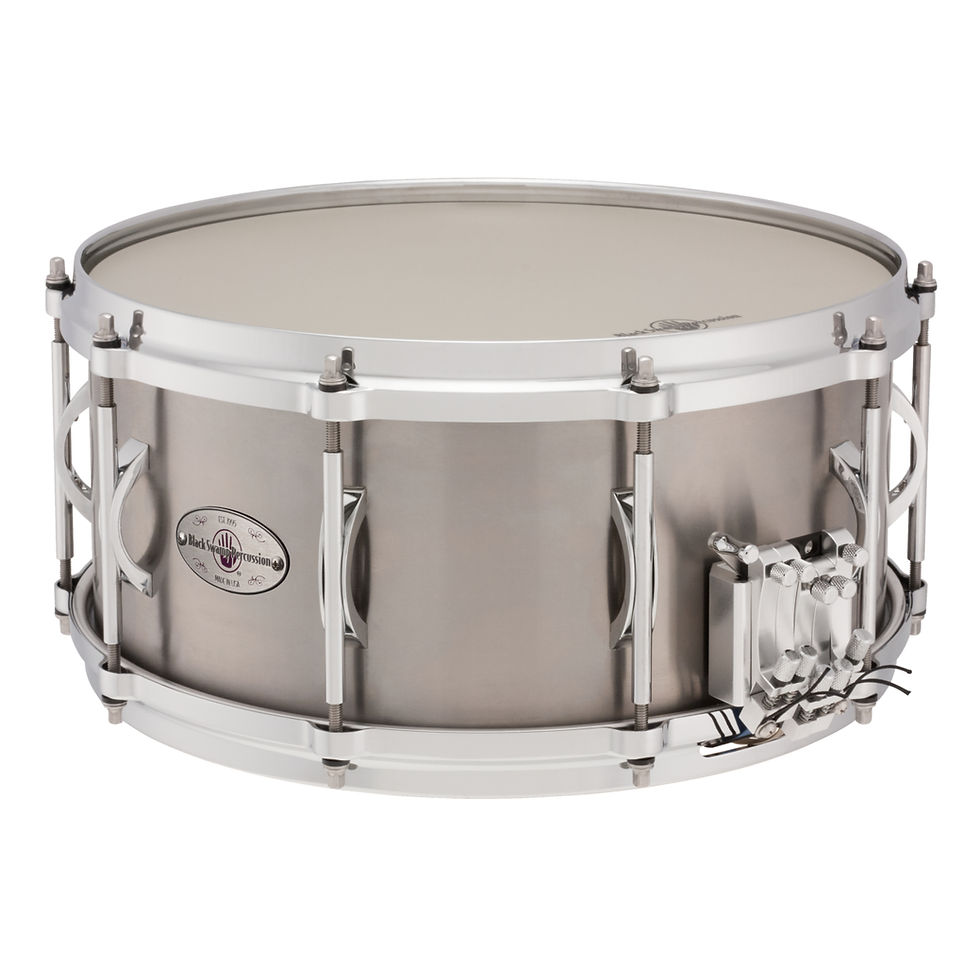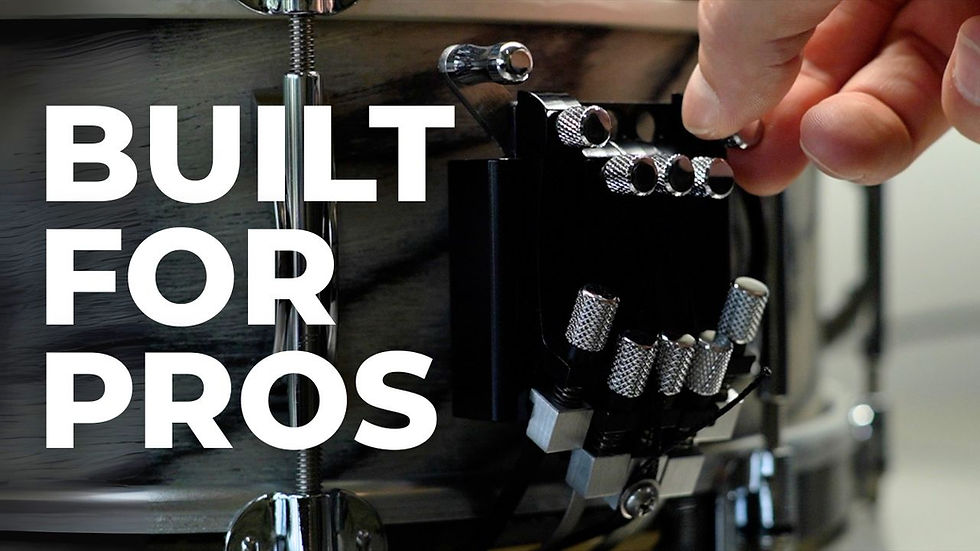Hear the Difference: A Sonic Guide to Choosing the Right Snare Drum with Gerardo Capaldo
- Nathan Coles
- Sep 26, 2025
- 4 min read
Pro percussionist Gerardo Capaldo demonstrates why the right drum choice is crucial for works by Shostakovich, Ravel, and more.
For the dedicated percussionist, the journey from playing notes to making music involves a series of thoughtful choices. Perhaps the most important one is selecting the right instrument for the job. Why does the snare drum in a Shostakovich symphony sound so different from the one in an opera by Verdi? In this guide, we’ll move beyond gear lists and dive into the world of sound, using popular orchestral excerpts to show how a professional player chooses the right tool for the musical moment.
Table of Contents
Don't miss a post! Sign up for the Black Swamp Newsletter for more tips, artist features, and product news.
Meet Your Instructor

Gerardo Capaldo is a Black Swamp Artist, permanent percussionist at Teatro alla Scala (IT) and member of the ensemble “I Percussionisti della Scala”. His daily work demands a deep understanding of how to select an instrument whose voice perfectly matches the music of the world's greatest composers.
Why One Snare Drum Doesn't Fit All
As Gerardo explains in the video, variables like heads, tuning, and wires all shape a drum's sound. But the drum's core identity—its shell material and size—is the foundation. A powerful, metallic drum designed to cut through a massive brass section would sound out of place in a delicate, impressionistic piece. Choosing the right snare drum is about interpreting the composer's intent and finding the voice that best tells the story.
Case Study: The Powerhouse for Shostakovich, Mahler & Rachmaninoff
The Musical Challenge:
Excerpts like the snare drum feature in Shostakovich's 9th Symphony (m. 73), the driving rhythms of Rachmaninoff's Symphonic Dances (m. 96), and the militaristic passages in Mahler's 6th Symphony are defined by their power and intensity. The snare drum cannot be timid; it needs a commanding presence and the articulation to be heard clearly over a thundering orchestra.
The Right Tool:
For this job, Gerardo reaches for his 6.5" x 14" Titanium Elite Multisonic Snare Drum. Watch as Gerardo demonstrates the power and projection of this drum on these iconic excerpts.
Why it Works:
The titanium shell produces a bright, loud, and cutting sound. As Gerardo notes, this drum provides the "very solid and strong presence" needed to drive the ensemble. The deeper 6.5" shell adds the necessary body and volume for its powerful voice to be felt as well as heard.
Case Study: The Workhorse for Scheherazade, Prokofiev & Mahler
The Musical Challenge:
Passages like the solos in the 3rd movement of Rimsky-Korsakov's Scheherazade, the famous offstage drum in Prokofiev's Lieutenant Kijé (check out our recent Kijé lesson with Shaun Tilburg), and the post horn solo accompaniment in Mahler's 3rd Symphony (m. 19) require a more nuanced voice. These moments demand focus, warmth, and control over raw power.
The Right Tool:
This is where the 5" x 14" 7-Ply Maple Multisonic Snare Drum shines. Listen for the focused, warm tone of the maple drum and see how it fits perfectly into these varied musical contexts.
Why it Works:
Maple provides the quintessential warm, classic wood sound. Gerardo highlights its "warmth and focus," which allow it to support the music without overpowering it. It has less raw volume than the titanium drum but offers superior blend and control, perfect for these varied and character-driven moments.
Case Study: The Colorist for Ravel & Von Suppé
The Musical Challenge:
When the music is about painting a picture with sound—think of the Spanish rhythms in Ravel's Alborada del gracioso (m. 26), the shimmering textures of his Daphnis et Chloé (m. 210), or the light, articulate passages in Von Suppé's Pique Dame overture—the focus shifts from power to timbre. These moments call for a unique, particular voice.
The Right Tool:
Gerardo uses his 5" x 14" Unibody Walnut Multisonic Snare Drum. Experience the unique character of the walnut drum and hear how it can be used to create fascinating sonic contrasts.
Why it Works:
The solid walnut shell produces a dark, rich, and resonant tone that is a "cross" between the other two drums. Gerardo uses it not only for its unique timbre but also as a second snare, placing it next to another to create a "timbral contrast that everyone can perceive." This is a perfect example of a pro using their gear to paint with sound.
Beyond the Shell: Fine-Tuning Your Sound
While the drum itself is the foundation, your sonic work isn't done after you've chosen your shell. If you're interested in learning more about the differences between shell materials, check out our blog post detailing metal vs wood shell. As Gerardo mentions at the start of the video, details like heads, wires, and tuning are crucial for shaping the final sound.
Heads: A coated, single-ply head will offer a classic, open sound with more overtones. Every Black Swamp snare drum is equipped with Remo Renaissance batter heads. These provide the right balance of tone and attack that we expect from a concert snare drum. However, opting for another brand or material like calf-skin or kangaroo hide will create a whole new sound for your instrument. Experiment and find what works best for you and your drum.
Snare Wires: The material and number of strands in your snare wires dramatically affect the drum's sensitivity and character. Coated cable snares can provide a darker, drier sound, while stainless steel wires might offer more brightness and articulation. Experimenting with different types of wires is an accessible way to change your drum's voice without buying a new drum.
Tuning: Finally, your tuning is what adapts the drum to the specific hall and ensemble. There's no single "correct" tuning—it's about listening to how the drum responds in the room and how it blends with the other instruments. Check out our Multisonic tuning guide and SoundArt snare drum tuning guide for some more detailed insight.
Beyond the Notes: Final Thoughts
As Gerardo concludes, there is a "world behind the snare drum." Learning to hear the differences, understanding why one instrument is better suited for a piece than another, and knowing how to fine-tune your sound are massive leaps in your musical development. It’s how you go from playing the part to becoming part of the music.






Comments